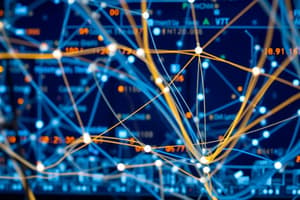Podcast
Questions and Answers
What is the primary function of a router in a network?
What is the primary function of a router in a network?
- To repeat incoming data signals to multiple devices
- To connect devices within a network
- To modulate and demodulate signals for internet connectivity
- To connect multiple networks and route traffic (correct)
What is the difference between a physical topology and a logical topology?
What is the difference between a physical topology and a logical topology?
- Physical topology is the way data flows, while logical topology is the physical layout
- Physical topology is used for LANs, while logical topology is used for WANs
- Physical topology is the physical layout, while logical topology is the way data flows (correct)
- Physical topology is used for wired networks, while logical topology is used for wireless networks
What is the primary function of the TCP protocol in the TCP/IP suite?
What is the primary function of the TCP protocol in the TCP/IP suite?
- To ensure reliable data transfer, error-checking, and correction (correct)
- To assign IP addresses and route packets
- To connect devices within a network
- To modulate and demodulate signals for internet connectivity
What is the primary function of a switch in a network?
What is the primary function of a switch in a network?
What is the primary function of a hub in a network?
What is the primary function of a hub in a network?
What is the primary function of the HTTP protocol?
What is the primary function of the HTTP protocol?
What is the primary difference between a LAN and a WAN?
What is the primary difference between a LAN and a WAN?
What is the primary function of a modem in a network?
What is the primary function of a modem in a network?
What type of network connects devices wirelessly in a limited area?
What type of network connects devices wirelessly in a limited area?
Flashcards are hidden until you start studying
Study Notes
Networking Fundamentals
Network Topologies
- Physical Topology: The physical layout of devices in a network
- Examples: Bus, Star, Ring, Mesh
- Logical Topology: The way data flows through a network
- Examples: Bus, Token Ring, Ethernet
Network Protocols
- TCP/IP (Transmission Control Protocol/Internet Protocol): A suite of protocols used for communication on the internet
- TCP: ensures reliable data transfer, error-checking, and correction
- IP: assigns IP addresses, routing, and packet forwarding
- HTTP (Hypertext Transfer Protocol): A protocol for transferring data over the internet
- Used for web browsing, requests, and responses
Network Devices
- Routers: Connect multiple networks, route traffic, and forward packets
- Switches: Connect devices within a network, forward packets, and manage traffic
- Hubs: Simple network devices that connect multiple devices, repeating incoming data signals
- Modems: Modulate and demodulate signals for internet connectivity
Network Types
- LAN (Local Area Network): A network that connects devices in a limited geographical area
- WAN (Wide Area Network): A network that covers a larger geographical area, often using telecommunications networks
- MAN (Metropolitan Area Network): A network that connects devices in a metropolitan area
- WLAN (Wireless Local Area Network): A network that connects devices wirelessly in a limited area
Networking Fundamentals
Network Topologies
- Physical Topology defines the physical layout of devices in a network, including bus, star, ring, and mesh configurations.
- Logical Topology defines the way data flows through a network, including bus, token ring, and ethernet configurations.
Network Protocols
TCP/IP Suite
- TCP (Transmission Control Protocol) ensures reliable data transfer, error-checking, and correction.
- IP (Internet Protocol) assigns IP addresses, routes, and forwards packets.
HTTP
- Hypertext Transfer Protocol is used for transferring data over the internet, specifically for web browsing, requests, and responses.
Network Devices
Routers
- Routers connect multiple networks, route traffic, and forward packets between networks.
Switches
- Switches connect devices within a network, forward packets, and manage traffic at the data link layer.
Hubs
- Hubs are simple network devices that connect multiple devices, repeating incoming data signals.
Modems
- Modems modulate and demodulate signals for internet connectivity, enabling data transmission over phone or cable lines.
Network Types
LAN
- Local Area Network (LAN) connects devices in a limited geographical area, such as a home, office, or building.
WAN
- Wide Area Network (WAN) covers a larger geographical area, often using telecommunications networks, such as a city or country.
MAN
- Metropolitan Area Network (MAN) connects devices in a metropolitan area, such as a university or business campus.
WLAN
- Wireless Local Area Network (WLAN) connects devices wirelessly in a limited area, such as a home or coffee shop.
Studying That Suits You
Use AI to generate personalized quizzes and flashcards to suit your learning preferences.




